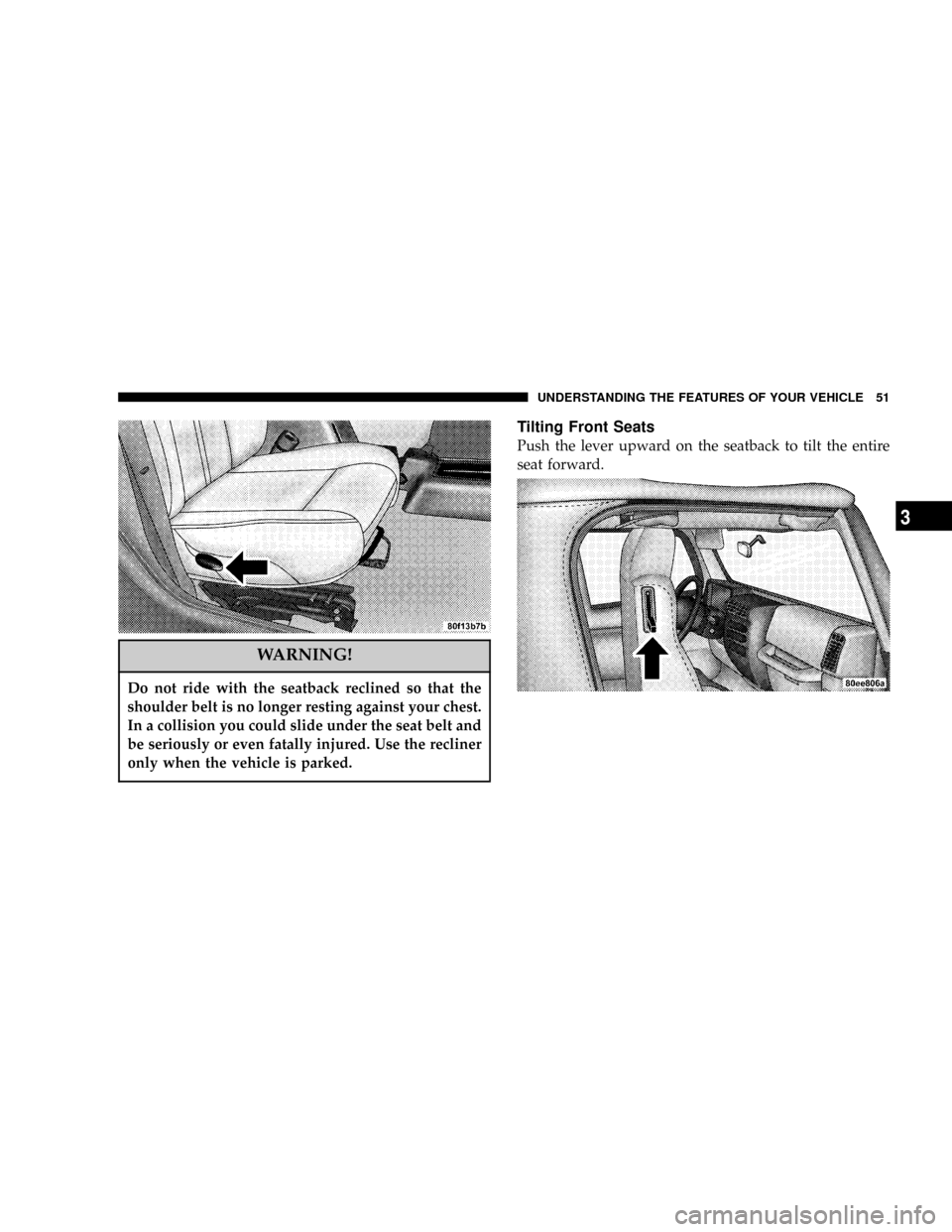warning JEEP WRANGLER 2004 TJ / 2.G Owner's Manual
[x] Cancel search | Manufacturer: JEEP, Model Year: 2004, Model line: WRANGLER, Model: JEEP WRANGLER 2004 TJ / 2.GPages: 299, PDF Size: 6.82 MB
Page 38 of 299

WARNING!
An incorrectly anchored tether strap could lead to
increased head motion and possible injury to the
child. Use only the anchor positions directly behind
the child seat to secure a child restraint top tether
strap.
Children Too Large for Booster Seats
Children who are large enough to wear the shoulder belt
comfortably, and whose legs are long enough to bend
over the front of the seat when their back is against the
seat back should use the lap/shoulder belt in a rear seat.
²Make sure that the child is seated upright in the seat.
²The lap belt portion should be low on the hips and as
snug as possible.
²Check belt fit periodically. A child's squirming or
slouching can move the belt out of position.
Rear Seat Tether Anchor
38 THINGS TO KNOW BEFORE STARTING YOUR VEHICLE
Page 40 of 299

A new engine may consume some oil during its first few
thousand miles (kilometers) of operation. This should be
considered as a normal part of the break-in and not
interpreted as an indication of difficulty.
SAFETY TIPS
Exhaust Gas
WARNING!
Exhaust gases can injure or kill. They contain carbon
monoxide (CO) which is colorless and odorless.
Breathing it can make you unconscious and can
eventually poison you. To avoid breathing (CO)
follow the safety tips below.
²Do not inhale exhaust gases. They contain carbon
monoxide, a colorless and odorless gas which can kill.
Never run the engine in a closed area, such as a
garage, and never sit in a parked vehicle with the
engine running for a extended period. If the vehicle isstopped in an open area with engine running for more
than a short period, adjust the ventilation system to
force fresh, outside air into the vehicle.
²Guard against carbon monoxide with proper mainte-
nance. Have the exhaust system inspected every time
the vehicle is raised. Have any abnormal conditions
repaired promptly. Until repaired, drive with all side
windows fully open.
²Always run the climate control in panel or floor mode
when driving with any windows open, even if only
slightly, to help keep fresh air circulating inside ve-
hicle. Otherwise poisonous gases could be drawn into
the vehicle.
²On hardtop models, keep the tailgate window closed
when driving your vehicle. On fabric top models, do
not drive with the rear window curtain up unless the
side curtains are also open. This will prevent carbon
monoxide and other poisonous exhaust gases from
entering the vehicle.
40 THINGS TO KNOW BEFORE STARTING YOUR VEHICLE
Page 41 of 299

Safety Checks You Should Make Inside The
Vehicle
Seat Belts
Inspect the belt system periodically, checking for cuts,
frays and loose parts. Damaged parts must be replaced
immediately. Do not disassemble or modify the system.
Seat belt assemblies must be replaced after an accident if
they have been damaged (bent retractor, torn webbing,
etc.). If there is any question regarding belt or retractor
condition, replace the belt.
Airbag Warning Light
The light should come on and remain on for 6 to 8
seconds as a indicator check when the ignition switch is
first turned on. If the indicator is not lit during starting,
have it serviced. If the light stays on or comes on while
driving, have the system checked by an authorized
dealer.
Defrosters
Check operation by selecting the defrost mode and place
the blower control on high speed. You should feel the air
directed against the windshield.
Safety Checks You Should Make Outside The
Vehicle
Tires
Examine tires for excessive tread wear or uneven wear
patterns. Check for stones, nails, glass, or other objects
lodged in the tread. Inspect for tread cuts or sidewall
cracks. Check wheel nuts for tightness and tires (includ-
ing spare) for proper pressure.
Lights
Have someone observe the operation of all exterior lights
while you work the controls. Check turn signal and high
beam indicator lights on the instrument panel.
Fluid Leaks
Check area under vehicle after overnight parking for fuel,
coolant, oil, or other fluid leaks. Also, if gasoline fumes
are detected, the cause should be located and corrected
immediately.
THINGS TO KNOW BEFORE STARTING YOUR VEHICLE 41
2
Page 50 of 299

WARNING!
²Vehicles and other objects seen in the right side
convex mirror will look smaller and f arther away
than they really are. Relying too much on your
right side mirror could cause you to collide with
another vehicle or other object.
²Use your inside mirror when judging the size or
distance of a vehicle seen in the right side mirror.
SEATS
WARNING!
Adjusting a seat while the vehicle is moving is
dangerous. The sudden movement of the seat could
cause you to lose control. The seat belt might not be
properly adjusted and you could be injured. Adjust
any seat only while the vehicle is parked.
Front Seat Adjustment
Move seat forward or rearward by lifting the lever. Be
sure the latch engages fully.
Front Seat Adjustment Ð Recline
To adjust seatback, lift lever, lean back, and release lever
at desired position. To return seatback, lift the lever, lean
forward and release the lever.
50 UNDERSTANDING THE FEATURES OF YOUR VEHICLE
Page 51 of 299

WARNING!
Do not ride with the seatback reclined so that the
shoulder belt is no longer resting against your chest.
In a collision you could slide under the seat belt and
be seriously or even fatally injured. Use the recliner
only when the vehicle is parked.
Tilting Front Seats
Push the lever upward on the seatback to tilt the entire
seat forward.
UNDERSTANDING THE FEATURES OF YOUR VEHICLE 51
3
Page 53 of 299

4. Secure the seat with the strap. Wrap strap around
sport bar, and put one end of the strap through loop of
the other end. Pull to tighten strap around sport bar.
Place the opposite loop around hook of seat. Route the
strap so that it is between the plates of the seat to
eliminate slack and increase tension, as shown.
5. When completed, return seat to it's normal position.Removing the Rear Seat
WARNING!
²It is extremely dangerous to ride in a cargo area,
inside or outside of a vehicle. In a collision people
riding in these areas are more likely to be seri-
ously injured or killed.
²Do not allow people to ride in any area of your
vehicle that is not equipped with seats and seat
belts.
²Be sure everyone in your vehicle is in a seat and
using a seat belt properly.
UNDERSTANDING THE FEATURES OF YOUR VEHICLE 53
3
Page 54 of 299

²First fold the rear seat forward following steps 1
through 3 under ªFold and Tumble Rear Seatº in this
section.
²Press down on release bar on each side, and pull seat
out and away from lower bracket.
²Remove seat from the vehicle.
Replacing the Rear Seat
Reverse steps for removing the seat. Be certain to pull the
seat belts between the seat cushion and seatback. Position
them for passenger use.
WARNING!
²To help protect against personal injury, passen-
gers should not be seated in the rear cargo area
with the rear seat folded down or removed from
the vehicle.
²The rear cargo space is intended for load carrying
purposes only, not for passengers, who should sit
in seats and use seat belts.
54 UNDERSTANDING THE FEATURES OF YOUR VEHICLE
Page 56 of 299

WARNING!
If the hood is not fully latched, it could fly up when
the vehicle is moving and block your forward vision.
Be sure all hood latches are latched fully before
driving.
LIGHTS
Interior Lights
The overhead light comes on when a door is opened. It
may also be turned on by rotating the control for the
dimmer switch on the muti-function control lever fully
upward.
The overhead light will automatically turn off in about 20
minutes if a door is left open or the dimmer control is left
in the dome light position. Turn the ignition switch ON to
restore the overhead light operation.
Daytime Brightness Feature
Certain instrument panel components (odometer, radio
display) can be illuminated at full brightness during the
daytime. This can be helpful when driving with your
headlights on during the daytime such as in a parade or
a funeral procession. To activate this feature, rotate the
left stalk one detent lower than the dome light.
Multi-Function Control Lever
The multi-function control lever controls the operation of
the parking lights, headlights, headlight beam selection,
passing light, fog lights, instrument panel light dimming,
and turn signals.
56 UNDERSTANDING THE FEATURES OF YOUR VEHICLE
Page 60 of 299

TILT STEERING COLUMN
To tilt the column, push down on the lever below the turn
signal control and move the wheel up or down, as
desired. Pull the lever back upwards to lock the column
firmly in place.WARNING!
Tilting the steering column while the vehicle is
moving is dangerous. Without a stable steering col-
umn, you could lose control of the vehicle and have
an accident. Adjust the column only while the ve-
hicle is stopped. Be sure it is locked before driving.
ELECTRONIC SPEED CONTROL
When engaged, this device takes over accelerator opera-
tions at speeds greater than 35 mph (60 km/h). The
controls are mounted on the steering wheel and consist of
ON´OFF, SET, RESUME/ACCEL, CANCEL, and COAST
controls.
60 UNDERSTANDING THE FEATURES OF YOUR VEHICLE
Page 62 of 299

To Accelerate for Passing
Depress the accelerator as you would normally. When the
pedal is released, the vehicle will return to the set speed.
NOTE:When driving uphill, at elevations above 2,000
ft. (610 meters), or when the vehicle is heavily loaded
(especially when towing) the vehicle may slow below the
SET speed. (If the vehicle speed drops below 30 mph (48
km/h), the Speed Control will automatically disengage).
If this happens, you can push down on the accelerator
pedal to maintain the desired speed.
WARNING!
Leaving the Speed Control on when not in use is
dangerous. You could accidentally set the system or
cause it to go faster than you want. You could lose
control and have an accident. Always turn the system
off when you are not using it.
CIGAR LIGHTER AND ASHTRAYS Ð IF
EQUIPPED
The vehicle may be equipped with a cigar lighter recep-
tacle, element, and ashtray (Smoker's Package Only). The
cigar lighter will be located in the lower instrument panel
(near the heater controls), and the removable ashtray will
be located in the center console.
62 UNDERSTANDING THE FEATURES OF YOUR VEHICLE